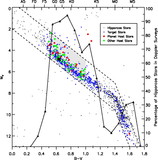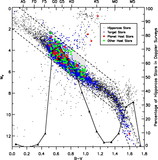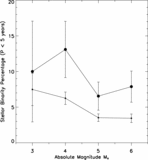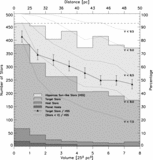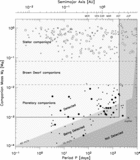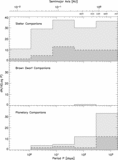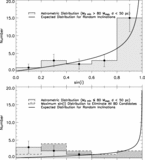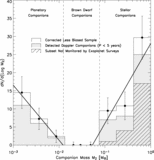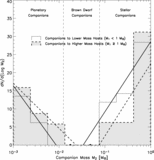Image Details
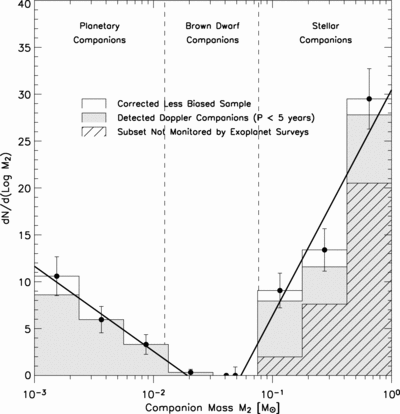
Caption: Fig. 9.
Same as Fig. 8, but for the larger 50 pc sample renormalized to the size of the 25 pc sample. Fitting straight lines using a weighted least‐squares fit to the three bins on the LHS and RHS gives us gradients of ﹩-9.1\pm 2.9﹩ and ﹩24.1\pm 4.7﹩, respectively (solid lines). Hence, the brown dwarf desert is significant at more than the 3 σ level. These LHS and RHS slopes agree to within about 1 σ of those in Fig. 8. The ratio of the number of companions on the LHS to the RHS is also about the same for both samples. Hence, the relative number and distribution of companions is approximately the same as in Fig. 8. The separate straight line fits to the three bins on the LHS and RHS intersect at ﹩M=43^{+14}_{-23}M_{\mathrm{J}\,}﹩ beneath the abscissa. Approximately 16% of the stars have companions in our less biased region. Of these, ﹩4.3\% \pm 1.0\% ﹩ have companions of planetary mass, ﹩0.1^{+0.2}_{-0.1}\% ﹩ have brown dwarf companions, and ﹩11.2\% \pm 1.6\% ﹩ have companions of stellar mass. We renormalize the mass distribution in this figure by comparing each bin in this figure with its corresponding bin in Fig. 8 and scaling the vertical axis of Fig. 9 so that the difference in height between the bins is on average a minimum. We find that the optimum renormalization factor is 0.33. This plot does not include the asymmetry correction for the planetary and stellar companions discussed in § 2.2 and shown in Table 2.
Copyright and Terms & Conditions
© 2006. The American Astronomical Society. All rights reserved. Printed in U.S.A.


